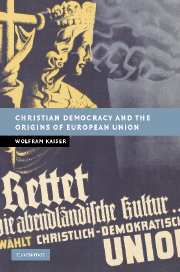Book contents
- Frontmatter
- Contents
- Acknowledgements
- Abbreviations
- Introduction
- 1 All paths to Rome? Transnational Catholicism in the nineteenth century
- 2 Under siege: Catholic parties in interwar Europe
- 3 After Versailles: left-Catholic cooperation
- 4 In the shadow of dictatorship: contacts in exile
- 5 Hegemony by default: Christian democracy in postwar Europe
- 6 Creating core Europe: the rise of the party network
- 7 Deepening integration: the supranational coalition embattled
- 8 Informal politics: from Rome to Maastricht
- Bibliography
- Index
- NEW STUDIES IN EUROPEAN HISTORY
4 - In the shadow of dictatorship: contacts in exile
Published online by Cambridge University Press: 14 July 2009
- Frontmatter
- Contents
- Acknowledgements
- Abbreviations
- Introduction
- 1 All paths to Rome? Transnational Catholicism in the nineteenth century
- 2 Under siege: Catholic parties in interwar Europe
- 3 After Versailles: left-Catholic cooperation
- 4 In the shadow of dictatorship: contacts in exile
- 5 Hegemony by default: Christian democracy in postwar Europe
- 6 Creating core Europe: the rise of the party network
- 7 Deepening integration: the supranational coalition embattled
- 8 Informal politics: from Rome to Maastricht
- Bibliography
- Index
- NEW STUDIES IN EUROPEAN HISTORY
Summary
Those Catholic politicians who actually went into exile before the start of World War II usually felt even more isolated abroad than refugees of a different political persuasion. The Catholic exile community was small. Compared to the communists and social democrats, few Catholic politicians went into exile while Mussolini was consolidating his power in Italy during 1922–6, after Hitler destroyed the remnants of legality in Germany in 1933 and after the annexation of Austria by Germany in March 1938. In Italy, many conservative Catholics deserted the PPI for the fascists after 1922–4. Many more Catholic politicians there, as well as in Germany and in Austria, preferred internal emigration to exile. De Gasperi, the last PPI leader, worked in the Vatican library. Adenauer, who was sacked by the National Socialists as mayor of Cologne in 1933, retired to a house in Rhöndorf near Bonn. He later refused to establish close contact with the German resistance for fear of reprisals against his family, but apparently also because he saw the total collapse of the regime as a precondition for successful postwar reconstruction and democratisation.
At the same time, many younger, socially ‘progressive’ Catholic democrats joined the resistance. This is true of Josef Müller, the first postwar leader of the Bavarian Christlich-Soziale Union (CSU), the Christian Social Union. Müller knew Pope Pius XII from his time as papal nuntius in Munich.
- Type
- Chapter
- Information
- Christian Democracy and the Origins of European Union , pp. 119 - 162Publisher: Cambridge University PressPrint publication year: 2007



